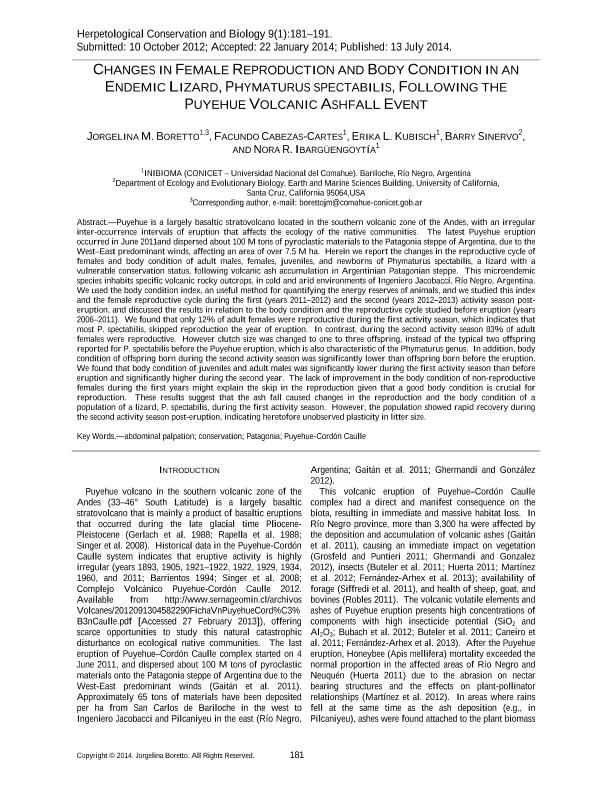Mostrar el registro sencillo del ítem
dc.contributor.author
Boretto, Jorgelina Mariela

dc.contributor.author
Cabezas, Facundo

dc.contributor.author
Kubisch, Erika Leticia

dc.contributor.author
Sinervo, Barry
dc.contributor.author
Ibarguengoytía, Nora

dc.date.available
2017-01-30T20:24:30Z
dc.date.issued
2014-07
dc.identifier.citation
Boretto, Jorgelina Mariela; Cabezas, Facundo; Kubisch, Erika Leticia; Sinervo, Barry; Ibarguengoytía, Nora; Changes in female reproduction and body condition in an endemic lizard, Phymaturus Spectabilis, following the Puyehue volcanic ashfall event; Herpetological Conservation and Biology; Herpetological Conservation and Biology; 9; 1; 7-2014; 181-191
dc.identifier.issn
1931-7603
dc.identifier.uri
http://hdl.handle.net/11336/12205
dc.description.abstract
Puyehue is a largely basaltic stratovolcano located in the southern volcanic zone of the Andes, with an irregular inter-occurrence intervals of eruption that affects the ecology of the native communities. The latest Puyehue eruption occurred in June 2011and dispersed about 100 M tons of pyroclastic materials to the Patagonia steppe of Argentina, due to the West–East predominant winds, affecting an area of over 7.5 M ha. Herein we report the changes in the reproductive cycle of females and body condition of adult males, females, juveniles, and newborns of Phymaturus spectabilis, a lizard with a vulnerable conservation status, following volcanic ash accumulation in Argentinian Patagonian steppe. This microendemic species inhabits specific volcanic rocky outcrops, in cold and arid environments of Ingeniero Jacobacci, Río Negro, Argentina. We used the body condition index, an useful method for quantifying the energy reserves of animals, and we studied this index and the female reproductive cycle during the first (years 2011–2012) and the second (years 2012–2013) activity season posteruption, and discussed the results in relation to the body condition and the reproductive cycle studied before eruption (years 2006–2011). We found that only 12% of adult females were reproductive during the first activity season, which indicates that most P. spectabilis, skipped reproduction the year of eruption. In contrast, during the second activity season 83% of adult females were reproductive. However clutch size was changed to one to three offspring, instead of the typical two offspring reported for P. spectabilis before the Puyehue eruption, which is also characteristic of the Phymaturus genus. In addition, body condition of offspring born during the second activity season was significantly lower than offspring born before the eruption. We found that body condition of juveniles and adult males was significantly lower during the first activity season than before eruption and significantly higher during the second year. The lack of improvement in the body condition of non-reproductive females during the first years might explain the skip in the reproduction given that a good body condition is crucial for reproduction. These results suggest that the ash fall caused changes in the reproduction and the body condition of a population of a lizard, P. spectabilis, during the first activity season. However, the population showed rapid recovery during the second activity season post-eruption, indicating heretofore unobserved plasticity in litter size.
dc.format
application/pdf
dc.language.iso
eng
dc.publisher
Herpetological Conservation and Biology
dc.rights
info:eu-repo/semantics/openAccess
dc.rights.uri
https://creativecommons.org/licenses/by-nc-sa/2.5/ar/
dc.subject
Abdominal Palpation
dc.subject
Conservation
dc.subject
Patagonia
dc.subject
Puyehue-Cordón Caulle
dc.subject.classification
Conservación de la Biodiversidad

dc.subject.classification
Ciencias Biológicas

dc.subject.classification
CIENCIAS NATURALES Y EXACTAS

dc.title
Changes in female reproduction and body condition in an endemic lizard, Phymaturus Spectabilis, following the Puyehue volcanic ashfall event
dc.type
info:eu-repo/semantics/article
dc.type
info:ar-repo/semantics/artículo
dc.type
info:eu-repo/semantics/publishedVersion
dc.date.updated
2016-12-12T14:28:31Z
dc.journal.volume
9
dc.journal.number
1
dc.journal.pagination
181-191
dc.journal.pais
Estados Unidos

dc.description.fil
Fil: Boretto, Jorgelina Mariela. Consejo Nacional de Investigaciones Científicas y Técnicas. Centro Científico Tecnológico Patagonia Norte. Instituto de Investigación En Biodiversidad y Medioambiente; Argentina. Universidad Nacional del Comahue; Argentina
dc.description.fil
Fil: Cabezas, Facundo. Consejo Nacional de Investigaciones Científicas y Técnicas. Centro Científico Tecnológico Patagonia Norte. Instituto de Investigación En Biodiversidad y Medioambiente; Argentina. Universidad Nacional del Comahue; Argentina
dc.description.fil
Fil: Kubisch, Erika Leticia. Consejo Nacional de Investigaciones Científicas y Técnicas. Centro Científico Tecnológico Patagonia Norte. Instituto de Investigación En Biodiversidad y Medioambiente; Argentina. Universidad Nacional del Comahue; Argentina
dc.description.fil
Fil: Sinervo, Barry. University Of California; Estados Unidos
dc.description.fil
Fil: Ibarguengoytía, Nora. Consejo Nacional de Investigaciones Científicas y Técnicas. Centro Científico Tecnológico Patagonia Norte. Instituto de Investigación En Biodiversidad y Medioambiente; Argentina. Universidad Nacional del Comahue; Argentina
dc.journal.title
Herpetological Conservation and Biology
dc.relation.alternativeid
info:eu-repo/semantics/altIdentifier/url/http://www.herpconbio.org/Volume_9/Issue_1/Boretto_etal_2014b.pdf
Archivos asociados
